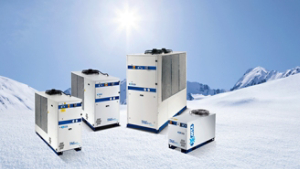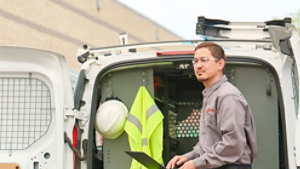
Q. What are some of the most challenging questions or concerns that you hear customers are facing right about operating their buildings or managing their energy?
A. When customers engage us, they're trying to save energy and they want to do things to improve their indoor air quality. Their challenge is how to marry the two because you can do one and adversely affect the other
For example, let's say we're trying to save energy. If we wanted to spend minimal time on it, we could say, “raise your cooling setpoints from 74 degrees to 78 degrees.” You may save energy that way but you’re going to cause an adverse reaction in your occupants who are used to having a comfortable environment. So, it’s important to identify how we can achieve energy savings without adversely impacting something else.
Q. What are some of the common misconceptions in the market today about improving reliability and resiliency, reducing energy emissions and reducing operational costs?
A. I think one of the common misconceptions is that if you do everything – improve reliability and resiliency, reduce energy emissions and reduce operational costs, you are going to adversely impact your indoor environment.
Going back to my temperature set point example if you raise the temperature set point in the summertime and lower it in the wintertime, that’s not a very productive way to accomplish your goals. What you want to make sure you do is align your efforts so that you can improve your indoor air quality while at the same time reducing your carbon footprint.
We can help people balance out reliability, resilience, energy emissions and operational goals without giving something up by starting with due diligence. We get into their buildings, ask people questions, and determine some of their issues and identify the best solutions to balance their needs. So, if they need an air handling unit replaced, for example, we try to make sure that it’s going to at least maintain or preferably improve their indoor environment.
Q. What do you think Trane brings to the table that nobody else can or does? What's our secret sauce?
A. We sell equipment and controls – there are only a couple of other vendors that do that. We've got our service footprint, a broad network of technicians so that there can be someone in their area who can stop by in an emergency to solve their problems and fix their equipment.
We also offer intelligent services — I don’t know if others are offering that. It allows you to track what’s happening so you can sit back, while being proactive, and learn about potential challenges before they become bigger issues.
I also think our account managers are involved and focused on our customer relationships. We're more visible and we’re in front of our customers more.
And most importantly, Trane focuses on the people. This means understanding the customer and their needs. We make sure that our technicians, for example, are comfortable working with customers. They keep customers updated as they are fixing their problems and provide documentation at the end of the job.
Q. How do you go about understanding customers’ real needs, in other words, the root cause behind building symptoms? How do you go about figuring all that out?
A. I talk to the customer whether starting at the C-suite or the maintenance level because we work with both. So, we to talk to the customer, understand what they see happening and then diagnose it from there. As the experts, we address the issue that the customer presents and get down in the weeds with it and really figure out what's going on and how to tackle it.
Q. Can you walk me through an example of how you have done that in the past?
A. Let’s look at school systems. When school systems have humidity problems what the customer knows is that is really humid in the building during the summer. Then we go through their building and find out that they have an extreme negative pressure issue. In other words, they're exhausting more airflow than they are putting into the building and conditioning. So, every time they open the door, they're pulling in very humid air from the outside. Once that humid air hits the air-conditioned space, the indoor humidity goes way up.
while they know that it's very humid inside, they don't know why. it's up to us to take look at customers’ buildings and see what’s going on. It's like a mechanic looking at a car. We go in and say, “the car is vibrating when we drive it.” Well, the mechanics going to look at the alignment, they're going to look at your steering column and everything and assess it all. That’s our job with buildings. We’re going to take how our customers feel about the problem and really diagnose it into its components and figure it out from there.
Q. How does building and energy data drive customer outcomes?
A. Energy data helps customers understand whether they are paying too much or less than what a typical building like theirs would pay. Then they can determine if they want to undertake a project and how much that could potentially save them. They can determine whether there is a way to incorporate energy savings into doing a bigger project and having some of the dollars that they now pay for utilities incorporated into paying for that project.
Q. If there was one, you know baseline metric that every customer should understand about their building, what is it and why?
A. The dollar-per-square-foot metric is probably the most important thing for any customer to know, whether it's a technical customer or a customer with no technical background. And everyone understands money so it’s an easy-to-understand metric. It helps you figure out if you need to take action and if it is high, whether to bring in an expert to diagnose why it is so high.
Q. What's your philosophy when it comes to helping customers to achieve their goals? How do you approach customers?
A. I put myself in my customer’s shoes to help them achieve their goals. I listen to their issues and say to myself, “if this were my building, is this what I would want to do?” And ultimately, if you do that, you're going to have their best interests in mind, always.
Q. If there is one service, every customer should be thinking about right now, what is it and why?
A. The one service every customer should be thinking about right now is a solid preventative maintenance program. If you've got a lot of big critical equipment that will cripple your operation if it goes down, make sure you have a preventive maintenance program in place to address that. You want to be proactive, not reactive.
Q. So what's your favorite part about working with our customers?
A. My favorite part of working with customers in general is solving their problems. They're asking us to address things they couldn't fix and it’s satisfying to do that for them. It’s rewarding to be the subject matter experts. They really trust us to bring to bring their buildings into a better state of indoor air quality and take some things off their capital improvement list. I enjoy working with them and solving their issues.
Q. What's the most challenging problem you've ever solved? How did you work your way through it?
A. There was a laboratory project on the east coast which involved very complex HVAC operations that needed attention and there was a lot of risk and potential liability involved.
We brought a team together to work on the project. If you have a laboratory, you've got a lot of safety contractors so we coordinated with them and developed a very solid solution that included both equipment replacement and getting a new life cycle on their aging equipment. We saved them in excess of $1 million a year.
Completing such a complicated project was really satisfying. We heard that other potential suppliers didn’t feel like it was a big opportunity, and we did. The project proved very visible and earned us a lot of kudos on the state level – even leading to additional projects.
Q. What do you think is the most important thing to do to build trust with the customer?
A. I think the most important thing to build trust with customers is to communicate with them. Customers can tell whether an energy service consultant has the best interests in mind or is just trying to sell them something. Good communication is a key part of that.
Q. What's your favorite part about working for Trane?
A. The best part about working for Trane is that we have a big footprint with a huge customer base and many of them need our attention, so there’s a lot of opportunities out there. When you work for Trane, you get a lot of control over your schedule and how you solve customer problems as long as you're getting things done. Trane allows me to focus on helping those customers in the best way possible.
Trane is a strategic business of Trane Technologies, a global climate innovator. Trane Technologies brings bold thinking to our customers to advance the conversation on sustainability and achieve more through sustainable climate solutions for buildings, homes, and transportation. We're leading the way to a better future, and we boldly go.

About the author
Craig Washburn, Project Engineer II - Energy
Craig Washburn, PE, is the Lead Senior Energy Engineer for the Virginia Southern Atlantic Region Team. He is a graduate of Virginia Tech University with a BS degree in Mechanical Engineering. Craig resides in Lynchburg, VA with his twin daughters and has worked for Trane for over 16 years. Craig has led multiple multi-million-dollar projects for State Agencies, public institutions and k-12 Schools

































































































